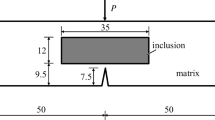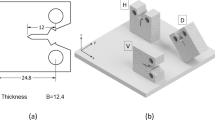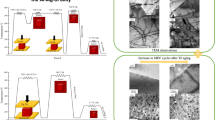Abstract
This paper presents a study of the interlaminar fracture of filament wound composites. Mode II end notched flexure (ENF) tests were performed on flat glass/polyester specimens. The tested specimens had asymmetric [±Θ]4 angle-ply stacking-sequences, with Θ values from 0.8° (hoop winding) to 30°. Due to the low stiffness and probable high toughness, it was not possible to propagate the crack in [±60°]4 specimens before they suffered considerable permanent deformations. A short support span had to be employed for [±30°]4 specimens in order to obtain crack propagation. Nevertheless, the results for those specimens should be viewed with caution, as some nonlinear behaviour and small permanent deformations were detected. No other unusual features, such as crack jumping to other interface, were observed. The scatter in the critical strain energy release rate values (G IIc ) was higher for [±10°]4 and [±30°]4 specimens than for the quasi-unidirectional ones. G IIc values from the insert were generally lower than those from mode II pre-cracks, except for quasi-unidirectional specimens. A plot of average G IIc values against Θ showed a minimum at Θ=5°.
Similar content being viewed by others
References
Williams, J. G., Davies, P., and Brunner, A. J., 'Standard Tests for the Toughness of Composite Laminates-Some Bones of Contention', Proceedings of the 10th International Conference on Composite Materials (ICCM-10), 1995, Vol. I, pp. 71-75.
Davies, P., Ducept, F., Brunner, A. J., Blackman, B. R. K., and Morais, A. B., 'Development of a Standard Mode II Shear Fracture Test Procedure', Proceedings of the 7th European Conference on Composite Materials (ECCM-7), 1996, Vol. 2, pp. 9-15.
Davies, P., Blackman, B. R. K., and Brunner, A. J., 'Standard Test Methods for Delamination Resistance of Composite Materials: Current Status', Applied Composite Materials 5, 1998, 345-364.
Davies, P. and Rannou, F., 'The Effect of Defects in Tubes: Part 1. Mode I Delamination Resistance', Applied Composite Materials 1, 1995, 333-347.
Ozdil, F., Carlsson, L. A., and Li, X., 'Characterization of Mode II Delamination Growth in Glass/Epoxy Composite Cylinders', Journal of Composite Materials 34, 2000, 274-298.
Ozdil, F. and Carlsson, L.A., 'Characterization of Mode I Delamination Growth in Glass/Epoxy Composite Cylinders', Journal of Composite Materials 34, 2000, 398-419.
Ozdil, F. and Carlsson, L. A., 'Characterization of Mixed Mode Delamination Growth in Glass/Epoxy Composite Cylinders', Journal of Composite Materials 34, 2000, 420-448.
Ozdil, F., Carlsson, L. A. and Davies, P., 'Beam Analysis of Angle-ply Laminate End-notched Flexure Specimens', Composites Science and Technology 58, 1998, 1929-1938.
Laksimi, A., Benyahia, A. A., Benzeggagh, M. L. and Gong, X. L., 'Initiation and Bifurcation Mechanisms of Cracks in Multi-Directional Laminates', Composites Science and Technology 60, 2000, 597-604.
Choi, N. S., Kinloch, A. J. and Williams, J. G., 'Delamination Fracture of Multidirectional Carbon-fiber/Epoxy Composites under Mode I, Mode II and Mixed-mode I/II Loading', Journal of Composite Materials 33, 1999, 73-100.
Tao, J. X. and Sun, C. T., 'Influence of Ply Orientation on Delamination in Composite Laminates', Journal of Composite Materials 32, 1998, 1933-1947.
Polaha, J. J., Davidson, B. D., Hudson, R. C., and Pieracci, A., 'Effects ofMode Ratio, Ply Orientation and Precracking on the Delamination Toughness of a Laminated Composite', Journal of Reinforced Plastics and Composites 15, 1996, 141-l73.
Davidson, B. D. and Schapery, R. A., 'Effect of Finite width on Deflection and Energy Release Rate of an Orthotropic Double Cantilever Beam Specimen', Journal of Composite Materials 22, 1988, 640-656.
Sun, C. T. and Zeng, S., 'Delamination Characteristics of Double Cantilever Beam and Endnotched Flexure Composite Specimens', Composite Science and Technology 56, 1996, 451-459.
Davidson, B. D., Krüger, R. and König,M., 'Three Dimensional Analysis and Resulting Design Recommendations for Unidirectional andMultidirectional End-notched Flexure Tests', Journal of Composite Materials 29, 1995, 2108-2133.
Nairn, J. A., 'Energy Release Rate Analysis for Adhesive and Laminate Double Cantilever Beam Specimens Emphasizing the Effect of Residual Stresses', International Journal of Adhesion and Adhesives 20, 2000, 59-70.
Davies, P. (ed.), Protocols for Interlaminar Fracture Testing of Composites, ESIS-Polymers & Composites Task Group, 1993.
Rights and permissions
About this article
Cite this article
de Morais, A.B., Silva, J.F., Marques, A.T. et al. Mode II Interlaminar Fracture of Filament Wound Angle-ply Specimens. Applied Composite Materials 9, 117–129 (2002). https://doi.org/10.1023/A:1013898312796
Issue Date:
DOI: https://doi.org/10.1023/A:1013898312796




